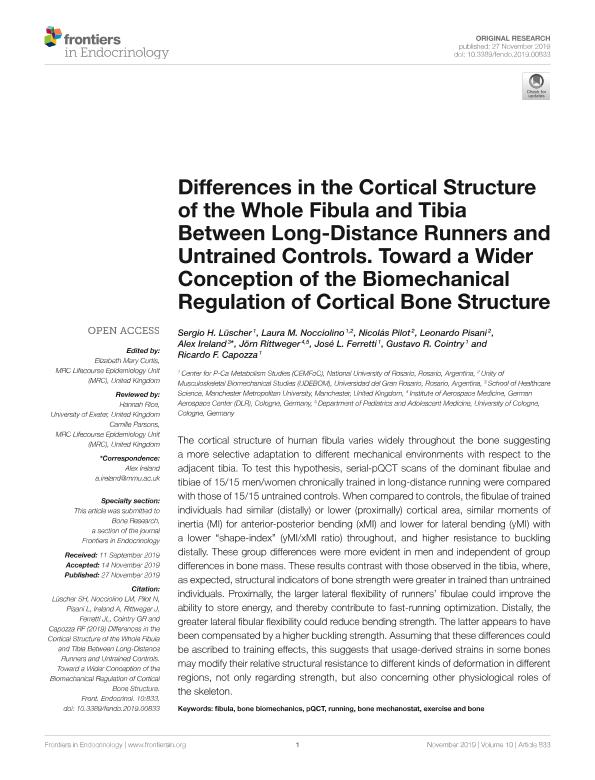Artículo
Differences in the Cortical Structure of the Whole Fibula and Tibia Between Long-Distance Runners and Untrained Controls: Toward a Wider Conception of the Biomechanical Regulation of Cortical Bone Structure
Luscher, Sergio Hugo; Nocciolino, Laura Marcela ; Pilot, Nicolas Carlos; Pisani, Leonardo; Ireland, Alex; Rittweger, Jörn; Ferretti, Jose Luis
; Pilot, Nicolas Carlos; Pisani, Leonardo; Ireland, Alex; Rittweger, Jörn; Ferretti, Jose Luis ; Cointry, Gustavo Roberto
; Cointry, Gustavo Roberto ; Capozza, Ricardo Francisco
; Capozza, Ricardo Francisco
 ; Pilot, Nicolas Carlos; Pisani, Leonardo; Ireland, Alex; Rittweger, Jörn; Ferretti, Jose Luis
; Pilot, Nicolas Carlos; Pisani, Leonardo; Ireland, Alex; Rittweger, Jörn; Ferretti, Jose Luis ; Cointry, Gustavo Roberto
; Cointry, Gustavo Roberto ; Capozza, Ricardo Francisco
; Capozza, Ricardo Francisco
Fecha de publicación:
11/2019
Editorial:
Frontiers Media
Revista:
Frontiers in Endocrinology
e-ISSN:
1664-2392
Idioma:
Inglés
Tipo de recurso:
Artículo publicado
Clasificación temática:
Resumen
The cortical structure of human fibula varies widely throughout the bone suggesting a more selective adaptation to different mechanical environments with respect to the adjacent tibia. To test this hypothesis, serial-pQCT scans of the dominant fibulae and tibiae of 15/15 men/women chronically trained in long-distance running were compared with those of 15/15 untrained controls. When compared to controls, the fibulae of trained individuals had similar (distally) or lower (proximally) cortical area, similar moments of inertia (MI) for anterior-posterior bending (xMI) and lower for lateral bending (yMI) with a lower “shape-index” (yMI/xMI ratio) throughout, and higher resistance to buckling distally. These group differences were more evident in men and independent of group differences in bone mass. These results contrast with those observed in the tibia, where, as expected, structural indicators of bone strength were greater in trained than untrained individuals. Proximally, the larger lateral flexibility of runners' fibulae could improve the ability to store energy, and thereby contribute to fast-running optimization. Distally, the greater lateral fibular flexibility could reduce bending strength. The latter appears to have been compensated by a higher buckling strength. Assuming that these differences could be ascribed to training effects, this suggests that usage-derived strains in some bones may modify their relative structural resistance to different kinds of deformation in different regions, not only regarding strength, but also concerning other physiological roles of the skeleton.
Archivos asociados
Licencia
Identificadores
Colecciones
Articulos(CCT - ROSARIO)
Articulos de CTRO.CIENTIFICO TECNOL.CONICET - ROSARIO
Articulos de CTRO.CIENTIFICO TECNOL.CONICET - ROSARIO
Citación
Luscher, Sergio Hugo; Nocciolino, Laura Marcela; Pilot, Nicolas Carlos; Pisani, Leonardo; Ireland, Alex; et al.; Differences in the Cortical Structure of the Whole Fibula and Tibia Between Long-Distance Runners and Untrained Controls: Toward a Wider Conception of the Biomechanical Regulation of Cortical Bone Structure; Frontiers Media; Frontiers in Endocrinology; 10; 11-2019; 1-13
Compartir
Altmétricas



